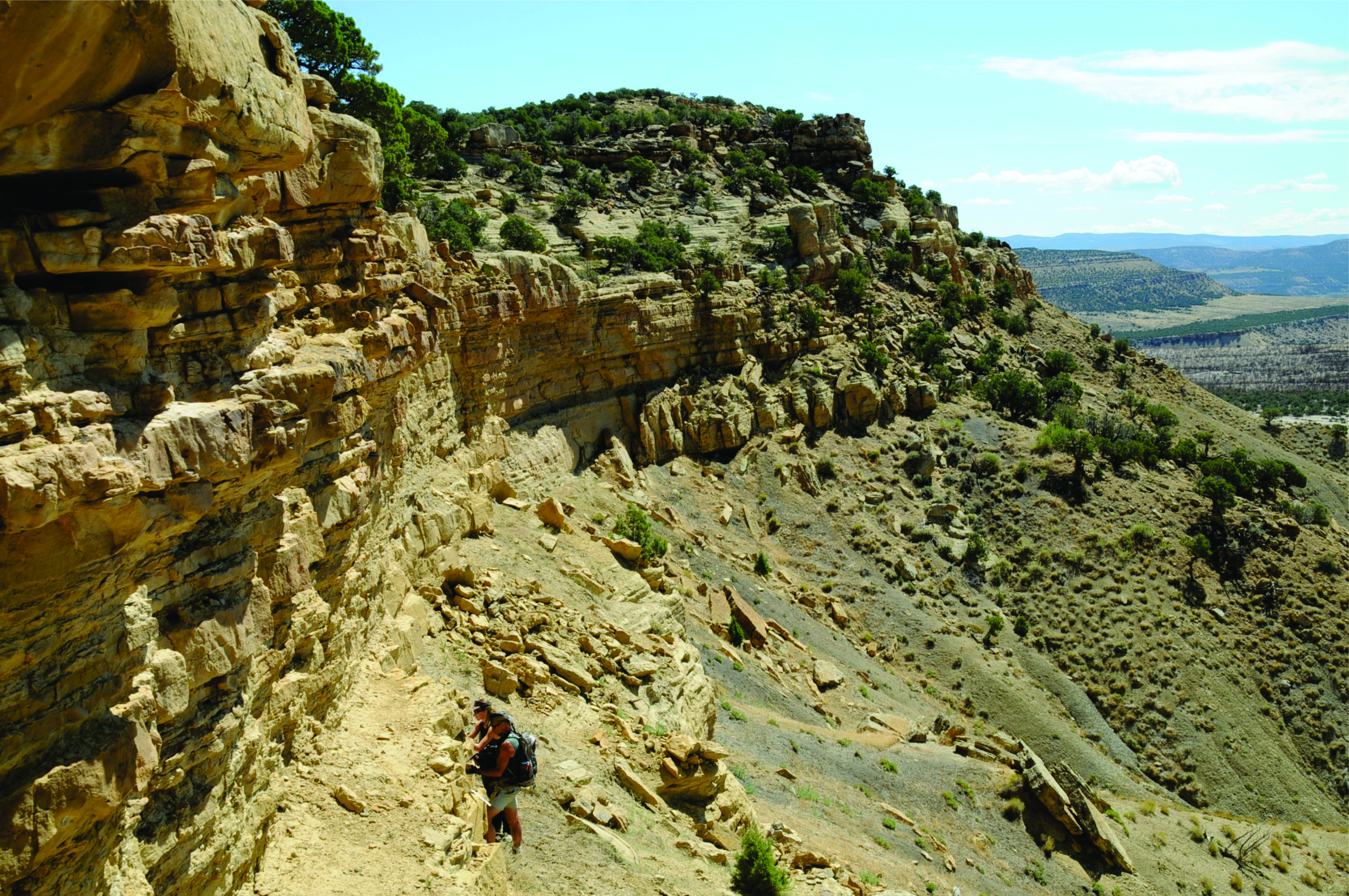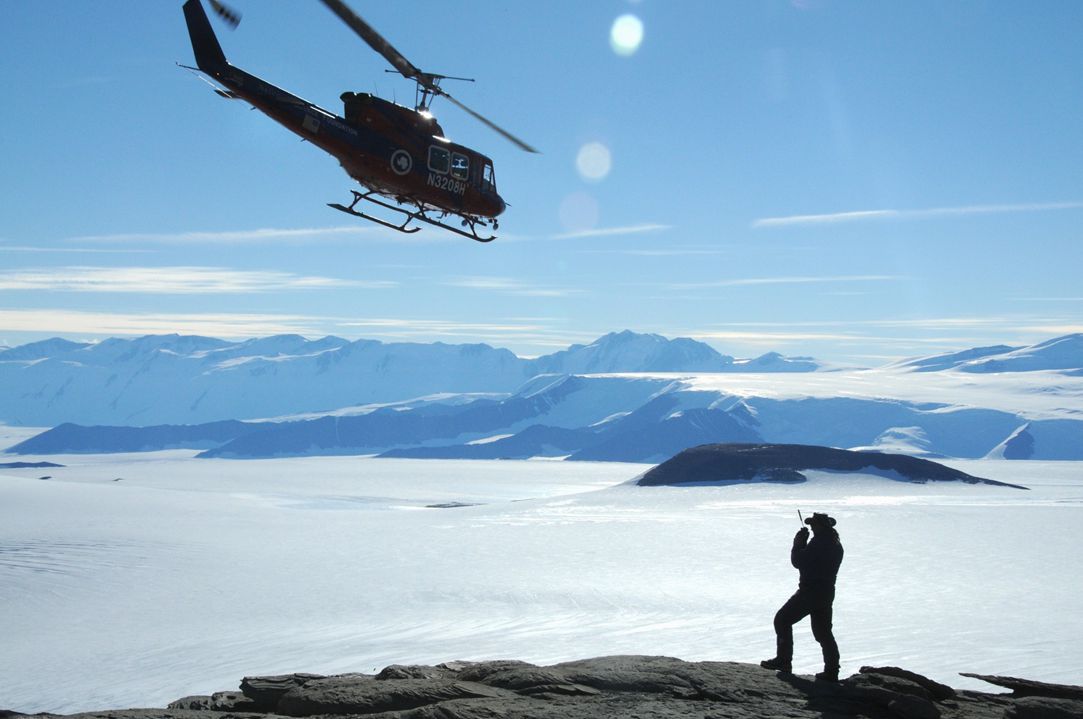About Dr. Peter Flaig
Dr. Flaig is a Research Scientist at the Bureau of Economic Geology. He received a BS and MS in geology with a focus on clastic sedimentology from the University of Wisconsin-Milwaukee and a Ph.D. in geology focusing on clastic sedimentology and stratigraphy from the University of Alaska Fairbanks. His master’s work took him to the Central Transantarctic Mountains of Antarctica, where he examined a change in sedimentation pattern across the Permian-Triassic boundary related to the interplay of climate warming and active tectonics. During his Ph.D. research on the North Slope of Alaska, he collaborated with paleontologists on a project to reveal the ancient ecosystem preserved in the dinosaur-bearing Prince Creek Formation.
Dr. Flaig joined the Bureau of Economic Geology in 2009 for a 2-year postdoctoral fellowship focused on additional Alaska research and fluvial-deltaic deposits of the Cretaceous Western Interior Seaway. He then spent 7 years as the lead scientist on fluvial, deltaic, and shallow marine research in the Quantitative Clastics Laboratory. He now works for the State of Texas Advanced Resource Recovery program and Alaska North Slope Integrated Projects program.
What are your current research activities?
The primary focus of my research is to identify the sedimentologic, ichnologic, and architectural characteristics of deposits of ancient fluvial-deltaic systems, the controls behind these stratal characteristics, and the spatial and temporal evolution of these systems. Much of the work I do involves applying large-scale outcrop belts as analogs for petroleum reservoirs. As a professional photographer, I use high-resolution imagery—including GigaPan photomosaics and, more recently, drone photogrammetry—to characterize and quantify the internal architectures of outcrop belts.
My research involves integrated projects, and I and my students routinely collaborate with researchers at The University of Texas at Austin and other universities that specialize in complimentary disciplines including:
- detrital zircon geochronology (provenance analysis and dating)
- geochemistry (e.g., paleosols, lacustrine-palustrine sediments)
- geophysics
- stable isotopes (climate)
- paleontology
- paleobotany
- palynology
- petrology
- 2D/3D seismic interpretation
- stratigraphic forward modeling
Our goals are to provide industry with highly detailed descriptions and interpretations of laterally extensive outcrop belts and to identify the building blocks of these outcrops so they can be used to improve predictability in frontier petroleum-producing basins.
A significant part of my research also involves collaborations with paleontologists and paleobotanists to place faunal and floral assemblages within the context of ancient evolving ecosystems, and to identify controls on changes in sedimentation pattern across extinction events and during periods of climate change.
What excites you the most about your current research?
It is extremely exciting and satisfying to recognize that the more collaborative, interdisciplinary, and integrated a sedimentologic-based study is, and the more cutting-edge the tools used to help test hypotheses and solve problems are, the more robust, rich, and informative the results turn out to be. Combining datasets in which the understanding that results from the whole is greater than any interpretations gleaned from the individual parts is where the true excitement and passion in my research lies. For example, integrating sedimentology, ichnology, paleobotany, and high-resolution 2D/3D imagery provides a wealth of data that, when integrated, become a much more powerful tool to refine paleoenvironmental interpretations and inform reservoir models. The digital revolution also continues to provide new, innovative tools for solving sedimentologic and stratigraphic problems. I see enormous potential in using drone photogrammetry to develop georeferenced 3D models of large outcrop belts that can be mined for quantitative data.
What is the desired outcome of your research?
Sedimentology-stratigraphy-ichnology is an ever-changing, continuously evolving discipline, and the desired outcomes are dynamic. My goal is to continually refine our understanding of the controls on the characteristics of deposits of fluvial, distal distributive, paralic-deltaic, shelfal clastic, and mixed carbonate-clastic systems. Providing data, interpretations, and evidence for underlying controls on characteristics of these systems that can be incorporated into reservoir models, basin models, and stratigraphic forward models are key outcomes. Developing broader understandings of how Earth’s climate and crust have evolved over time and the response of depositional systems to changing accommodation and climate is paramount. Placing biota within a more extensive, paleoecological framework is a passion of mine and is critical for understand the evolution of ecosystems.
What do you need to make your research efforts more successful?
Collaborators and students willing to take on new challenges are most important to improving success in my research. In my opinion, folks who do good science tend not to be islands unto themselves. Good sedimentologic-stratigraphic studies with goals of identifying controls on sedimentation tend to be regional in scope and require passionate people with diverse skill sets. Another key to success is efficiently integrating traditional sedimentologic field methods with cutting-edge digital and laboratory analysis, which can be very challenging. It would also be nice if there were 36 hours in a day!
What are your latest papers/publications, and what is most exciting about them?
I recently published a manuscript with colleagues that examined the sedimentologic, ichnologic, and architectural characteristics of the Loyd Formation, a heterolithic delta deposit near Rangely, Colorado.
Flaig, P. P., Hasiotis, S. T., Prather, T. J., and Burton, D., 2019, Characteristics of a Campanian delta deposit controlled by alternating river floods and tides: the Loyd Sandstone, Rangely Anticline, Colorado, USA: Journal of Sedimentary Research, v. 89, no. 12, p. 1181–1206, doi:10.2110/jsr.2019.63.
This publication is a detailed investigation of three different delta deposits that may look very similar at a large-scale, cursory glance. However, using process sedimentology, ichnology, and stratal architecture analysis at the centimeter to multi-meter scale, we can compare and contrast the characteristics of each delta deposit. We can then identify the underlying controls—including the interplay between sediment input, fluvial floods, tides, and their relative magnitudes and durations as well as sequence stratigraphic position—that drive the differences in the resulting deposits. On a small scale these differences may seem somewhat insignificant (e.g., the number and distribution of mud-drapes or poorly versus heavily burrowed mudstones), but on a large scale they may influence porosity, permeability, connectivity, and reservoir quality.
Who will benefit from your latest paper or publication?
I think that anyone concerned with or interested in reservoir characterization, scales of heterogeneity, and potential barriers and baffles to flow can benefit, including reservoir modelers and those working in basins with few or widespread core.
I also think the insights in this paper will benefit researchers who are addressing the question of relative time preserved in deltaic deposits that may have little material to date isotopically but are heterolithic with a variable trace fossil assemblage. We consider evidence for how relative time is recorded in the sand-rich beds, mud-rich beds, and trace fossil assemblage, and the controls on the distribution and stacking of these fluctuating facies and the ichnologic record.
What was your most exciting past paper or publication, and why?
I published two manuscripts in SEPM Special Publications on the Cretaceous Prince Creek Formation deposited on the North Slope of Alaska that, taken together, are my favorite. The Prince Creek Formation contains a record of the highest-latitude Maastrichtian dinosaur assemblage known, and is also a well-known viscous-to-heavy oil reservoir in the Colville Basin, Alaska.
Flaig, P. P., McCarthy, P. J., and Fiorillo, A. R., 2011, A tidally influenced, high-latitude coastal-plain: the Upper Cretaceous (Maastrichtian) Prince Creek Formation, North Slope, Alaska, in From river to rock record: the preservation of fluvial sediments and their subsequent Interpretation, SEPM Special Publication 97, p. 233–264, doi:10.2110/sepmsp.097.233.
Flaig, P. P., McCarthy, P. J., and Fiorillo, A. R., 2013, Anatomy, evolution, and paleoenvironmental interpretation of an ancient arctic coastal plain: Integrated paleopedology and palynology from the upper Cretaceous (Maastrichtian) Prince Creek Formation, North Slope, Alaska, USA, in New Frontiers in Paleopedology and Terrestrial Paleoclimatology, SEPM Special Publication 114, p. 179–230.
The first publication presents a model for the evolution of channel systems and crevasse splay complexes on the lower delta plain. We also develop a channel hierarchy, attempt to quantify the size and type of channel systems, and describe and interpret floodplain environments. All of this is meant to help reservoir modelers working in the Colville Basin and in other basins with similar deposits to recognize the potential spatial and temporal distribution of facies and architectures from an example in which we have laterally extensive exposures along tens of miles of river-cuts.
The second publication takes a higher-resolution look at the floodplains, examining micro- to macrofeatures of paleosols and integrating an extensive pollen and geochemical dataset. We then develop biofacies that help us type paleosols and assign them to different subenvironments along floodplains. With this information, we hypothesize that these high-latitude fluvial systems and floodplains were wet-dry flashy systems with characteristics driven by seasonal discharge related to a polar light and temperature regime during the Cretaceous Greenhouse.
Who are the types of research partners you are seeking, and what skills or expertise could benefit your research?
I work with colleagues who specialize in detrital zircon geochronology, geophysics, geochemistry, stable isotopes, paleontology, paleobotany, palynology, paleopedology, petrology, 2D/3D seismic interpretation, and stratigraphic forward modeling to name a few. All of these benefit my research by providing much broader, integrated datasets that better reveal the complex interrelated controls behind the resultant stratigraphy.
What are the desired relationships, expertise, or skills that could be brought in to benefit your research?
Recent integrated work with geophysicists, geochronologists, stratigraphic forward modelers, petroleum systems modelers and analysts, geochemists, paleobotanists, ichnologists, paleontologists, and other stratigraphers have all enriched my research program.
What have been recent successes associated with your research?
A major success in my career has been seeing graduate students that I mentor develop and test hypotheses and plan, instigate, and complete projects. I am also extremely proud of their continued success after graduation.
In Texas, we have some very interesting continuing work on Desmoinesian deposits from the eastern shelf of the Permian Basin and the Fort Worth Basin, investigating the character and evolution of deltaic deposits and mixed carbonate-clastic systems in the Strawn Group. We have also identified what we interpret as tidal signatures in proximal deposits of the Wilcox Formation.
In the Denver Basin, integrated and collaborative source-to-sink research that includes detrital zircon geochronology has provided new insights into sediment source and dispersal patterns.
On the North Slope of Alaska, some truly excellent integrated work—including integrated sedimentology, geophysical analysis, and stratigraphic forward modeling—has delivered new insights into the evolution and internal characteristics of clastic wedges and reservoirs in Brookian depositional systems.
Finally, in the Permian of Antarctica near the icehouse-to-greenhouse transition, we have identified deposits with characteristics of what I interpret to be the most “river-flood dominated” delta I have seen yet. We are also working to understand the drivers behind a change in fluvial style across the Permian-Triassic boundary and are planning a larger study that looks at the characteristics of and controls on sedimentation in early Triassic systems across the globe.
What is the geographic location of your research?
I have current projects or active collaborations with colleagues in Alaska, Antarctica, Canada, Colorado, Patagonia, Svalbard (Norway), Texas, Utah, and Wyoming.

Western United States research site (image provided by Dr. Peter Flaig).

Antarctica research site (image provided by Dr. Peter Flaig).